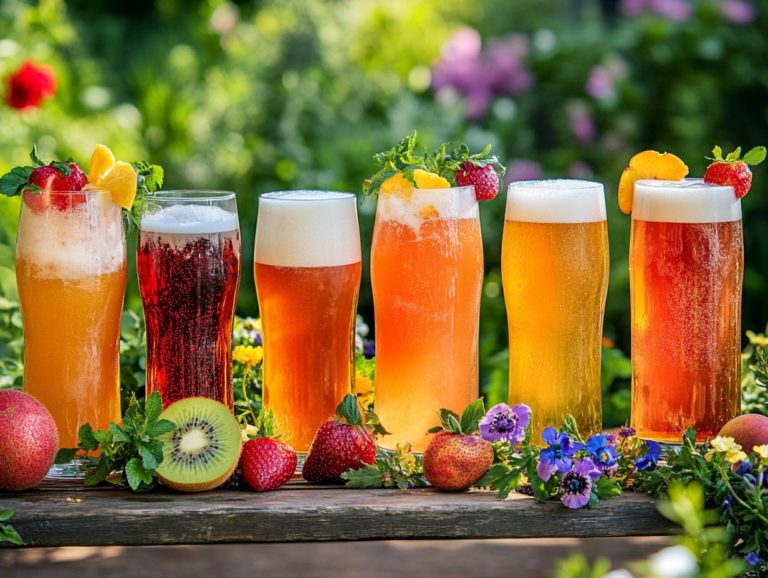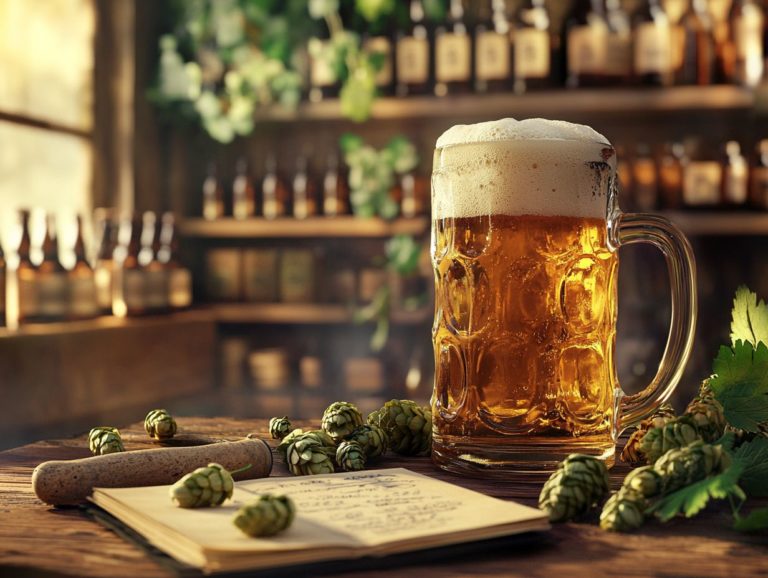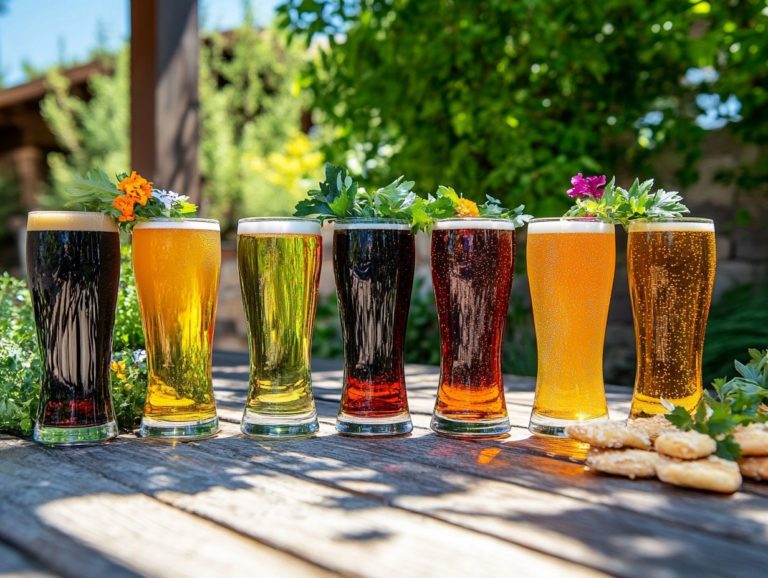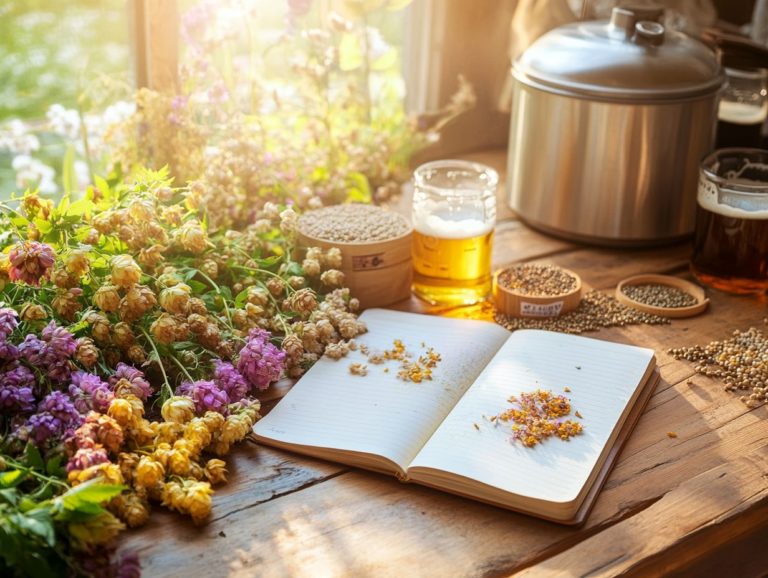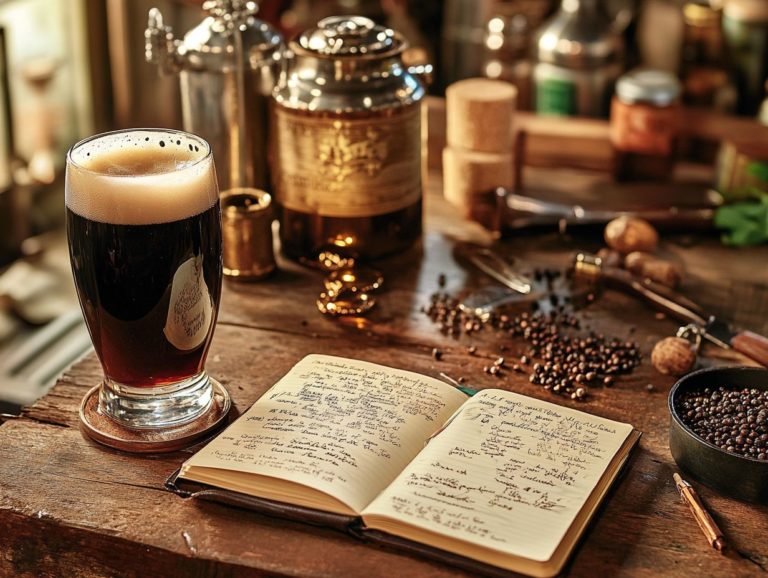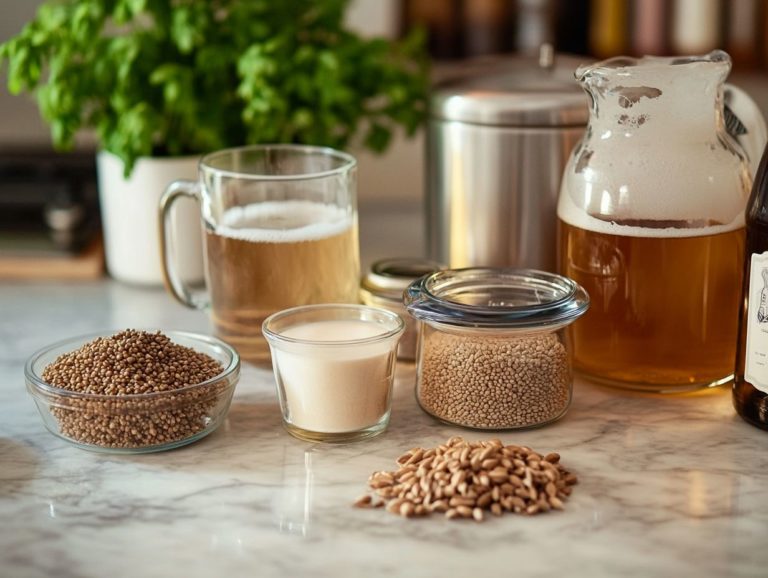Exploring the World of Belgian Beer Recipes
Belgian beer transcends mere refreshment; it embodies a rich tapestry of history, tradition, and unique brewing techniques that invite exploration. Its allure captivates beer enthusiasts around the globe, making Belgian beers a cornerstone of the craft beer scene.
In this article, you’ll journey through the captivating world of Belgian beer, delving into its distinctive styles like Trappist, Abbey, and Lambic, as well as newer Belgian-style beers. You’ll uncover what truly sets Belgian beer apart, from carefully selected ingredients to the intricate brewing processes that result in its exceptional character.
You will also find delicious beer recipes and expert tips to help you brew your own perfect Belgian beer, including popular clones like Blue Moon and Cranberry Lambic, along with thoughtful pairing suggestions designed to elevate your tasting experience.
Whether you’re a seasoned connoisseur or a curious newcomer, join us on this exciting journey and discover something delightful for every taste!
Contents
Key Takeaways:
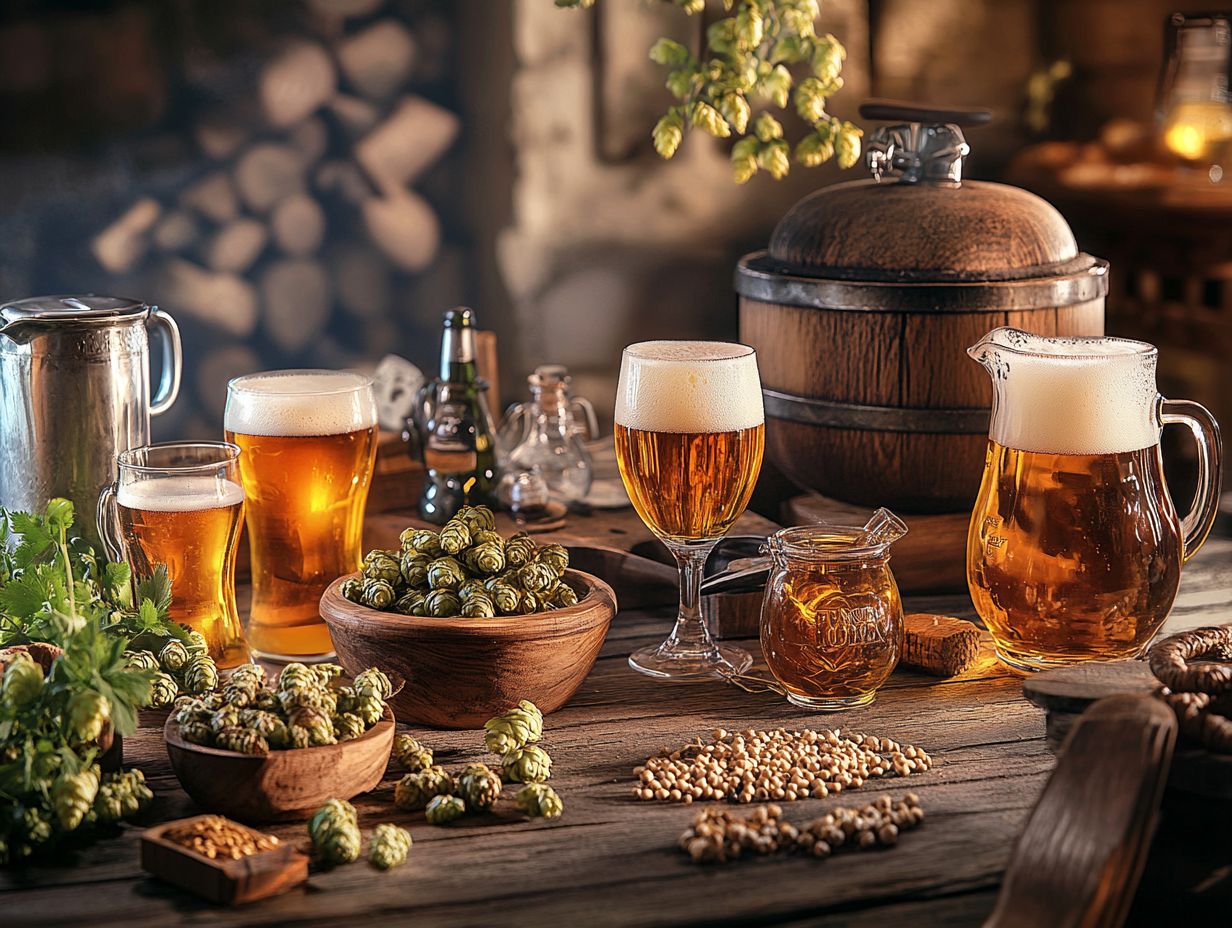
- Belgian beer is a unique and diverse style of beer with a rich history and distinct brewing methods.
- Belgian beer recipes include a variety of styles such as blonde ales, dubbels, tripels, and lambics, alongside American craft beer variations like Belgian Saison.
- Tips for brewing the perfect Belgian beer include choosing the right yeast, controlling fermentation temperature, and adding unique ingredients.
What is Belgian Beer?
Belgian beer embodies a rich tapestry of brewing heritage, marked by its diverse styles and unique flavors that set it apart from craft beers around the globe.
When you explore Belgian ales, you’ll discover a remarkable variety of ingredients and a culture steeped in artisanal brewing that has been honed over centuries.
With fruity and spicy notes, alongside the illustrious Belgian lambics and Trappist ales, this category of beer is celebrated worldwide for its complexity and exceptional craftsmanship. Beers like Rochefort 8 and Westmalle Tripel are perfect examples of the depth and character that Belgian beers offer, captivating both beer enthusiasts and connoisseurs alike.
History of Belgian Beer
The history of Belgian beer is intricately woven into the cultural and social tapestry of Belgium, tracing back centuries to an era when brewing was largely a monastic pursuit within Trappist breweries. These monasteries served as bastions of brewing craftsmanship, nurturing techniques that would blossom into a diverse spectrum of beer styles, shaping both local and international beer cultures.
Their influence persists in today’s craft beer culture, inspiring countless brewers worldwide. As time progressed, Belgian beers garnered acclaim for their remarkable complexity, inventive brewing methods, and distinctive flavors. This rich tradition is celebrated at iconic beer festivals in lively cities like Brussels, such as the Bruges Beer Festival, where enthusiasts come together to revel in the artistry of Belgian brewing.
What are the Trappist Beers of Belgium?
Trappist beers, crafted within the hallowed walls of Trappist monasteries in Belgium, stand out for their commitment to traditional brewing techniques and the use of high-quality ingredients. Each sip reveals the result of a time-honored process, showcasing a remarkable array of flavors. Among the most esteemed are Rochefort and Westmalle, both renowned for their unique characters and rich brewing heritages. These beers capture the monks’ passion for brewing and embody the intricate tapestry of Belgian brewing culture. The Institute of Brewing and Distilling recognizes the significance of these beers in preserving traditional brewing knowledge.
The appeal of Trappist beers goes beyond their distinctive flavors; it lies in their strict production guidelines. Each brew must be crafted by monks within a monastery, with a portion of the profits supporting the monastic community. This unique approach ensures that every bottle carries a piece of their devotion and legacy, contributing to the global craft beer scene.
As you explore these brews, you’ll encounter complex aromas and tastes. Consider Rochefort 10, a dark, malty masterpiece known for its rich, fruity notes, or the golden, mildly hoppy Westmalle Dubbel, which enchants with its smooth and slightly sweet profile. Not to be overlooked, notable Trappist breweries like Chimay and Orval contribute to this revered legacy, producing iconic drinks that beer enthusiasts around the globe eagerly seek.
Each brewery has its own captivating story and deep-rooted history, adding to the allure of Trappist beers within the vibrant landscape of the global craft beer scene.
What are the Abbey Beers of Belgium?
While Trappist beers are deeply rooted in monastic tradition, Abbey beers offer a broader exploration of Belgian brewing. Abbey beers represent a unique category within Belgian brewing, drawing inspiration from the rich traditions of monastery brewing, even if they’re not always crafted within the hallowed walls of an actual abbey. This style boasts a variety of subcategories, including the Belgian Abbey Single and the celebrated Dubbel and Tripel styles, each offering its own distinct flavor profile and brewing methods. You’ll find these beers lauded for their rich, complex flavors, often bursting with fruity and spicy notes that make them a favorite among discerning beer enthusiasts.
These brews utilize time-honored ingredients and techniques that trace back centuries, imbuing them with remarkable authenticity and heritage. While they may bear similarities to Trappist beers, Abbey beers can also be made by commercial breweries aiming to capture that same monastic spirit without being directly tied to a specific abbey.
The brewing methods frequently include a process where the beer undergoes a second fermentation in the bottle, a technique that naturally enhances carbonation and adds layers of complexity to the beer. Culturally, Abbey beers enjoy a revered status in Belgian society, often gracing tables during festive occasions and communal gatherings, reflecting a deep-rooted tradition of craftsmanship and camaraderie that connects people over shared experiences.
Dive into the world of Belgian beers and discover flavors that excite your palate!
What are the Lambic Beers of Belgium?
Lambic beers represent a traditional Belgian style that captivates the palate with their spontaneous fermentation process, drawing on wild yeasts and bacteria from the surrounding environment. This unique approach imparts a distinctive sour profile that sets Lambics apart. You’ll find an array of complex flavors within this category, including celebrated varieties like Flanders Brown and Gueuze, which artfully combine young and old Lambics to create a perfectly balanced taste. Breweries such as Brouwerij Boon have earned a reputation for excellence in Lambic production, showcasing the remarkable terroir of Belgium. Events like Toer de Geuze offer beer tourists an immersive experience in Lambic production.
This fermentation method relies heavily on local yeast strains, particularly Brettanomyces, along with various Lactobacillus and Pediococcus bacteria. The result? A beer that tantalizes the taste buds with tart, fruity, and funky notes. As you explore further, you’ll encounter styles like Fruit Lambics, which incorporate delightful fruits such as cherries or raspberries, and Faro, a sweeter version that often includes added sugar.
Notable producers like Cantillon and Brouwerij 3 Fonteinen are revered for their artisanal techniques, crafting Lambics that genuinely embody the unique characteristics and traditions of their regions. These exceptional breweries play a crucial role in preserving this centuries-old brewing method, continually delighting enthusiasts with the distinctive character and depth of flavor that only a well-crafted Lambic can deliver. Brewery hopping in regions like these offers a unique glimpse into Belgium’s brewing heritage.
What Makes Belgian Beer Unique?
The uniqueness of Belgian beer lies in its intricate brewing process, which often features a delightful array of local ingredients that contribute to its rich and diverse flavor profiles. The brewing challenges faced by Belgian brewers add to the allure, as they masterfully navigate the complexities of fermentation to produce world-class brews.
The fermentation techniques employed by Belgian brewers are crucial; they typically utilize specific strains of beer yeast that elevate the beer’s character, resulting in a captivating spectrum of flavors that can swing from fruity notes to spicy notes.
This complexity truly distinguishes Belgian beer within the craft beer landscape, making it an irresistible choice for enthusiasts around the globe. Belgian beers have even influenced American craft beer, inspiring brewers to create their own unique interpretations.
What are the Ingredients Used in Belgian Beer?
Belgian beers are crafted with an array of ingredients that are essential to their distinctive flavors and aromas, with a particular focus on selecting the right yeast, which plays a pivotal role in the fermentation process. Traditional Belgian ingredients, such as specialty malts, hops, and sugars, are meticulously chosen to weave a rich tapestry of flavors that can range from caramel and toffee to fruity and spicy notes, providing a truly unique tasting experience for discerning beer enthusiasts like you.
The yeast strains employed in Belgian brewing contribute unique esters and phenols that enhance the beer’s complexity, a defining characteristic of this esteemed brewing tradition. On the malt front, Belgian brewers utilize a diverse selection, from pale malts to richer varieties like Munich and crystal, each adding its distinct flavor and sweetness.
While hops are used more sparingly compared to other beer styles, they play a crucial role in adding bitterness and aromatic notes, balancing the sweetness derived from the malts. Moreover, the inclusion of candi sugar not only enhances fermentation but also elevates the alcohol content, further enriching the overall profile of these remarkable brews. The use of wild yeasts in certain styles, like lambics, adds another layer of complexity.
What are the Different Styles of Belgian Beer?
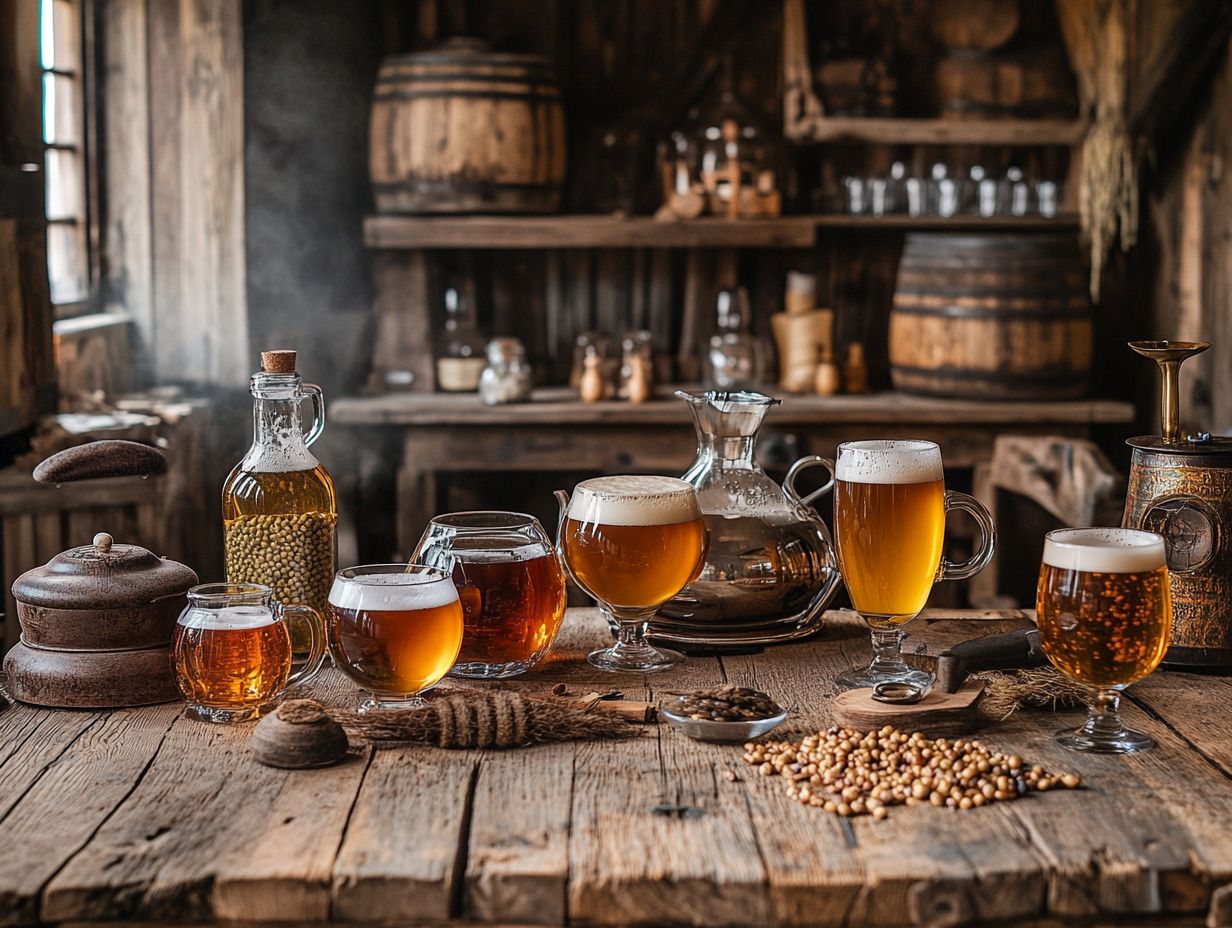
Belgian beer styles are incredibly diverse, encompassing everything from the light and crisp Witbier to the rich and robust Quadruple style. Other notable styles include Flanders Red and Flanders Brown, each offering a unique taste experience.
Belgian beer has a wide variety of styles. Each style features distinct characteristics and flavor profiles, making it one of the most diverse beer cultures globally. You ll encounter iconic styles like Dubbel, Tripel, Quadruple, and Witbier, celebrated not just for their taste but also for their rich brewing heritage and the myriad interpretations crafted by various breweries, including famous names like Rochefort and Westmalle.
Each style represents a unique brewing philosophy, resulting in a wide range of flavors and aromas that cater to a wide range of beer enthusiasts. This flourishing beer culture also attracts beer tourism, with activities such as brewery hopping and attending beer festivals like the Bruges Beer Festival.
Consider the rich, malty undertones of a Dubbel, often brewed with dark caramel sugars, which create a depth of flavor that’s hard to resist. Then there’s the Tripel, with its impressive higher-ABV profile that artfully balances sweetness with a warming alcohol finish truly remarkable. The Quadruple stands out with its deep flavor and smooth mouthfeel, showcasing the traditional Belgian yeast character, while a zesty Witbier refreshes the palate with delightful hints of citrus and coriander. Don t miss out on tasting Belgian ales from famous Trappist breweries; they offer an unforgettable experience!
Every brewing technique, whether it involves spontaneous fermentation a natural fermentation process that relies on wild yeast from the environment or meticulous temperature control, reflects a craftsmanship steeped in history. This dedication elevates not only the beer itself but also the overall experience of savoring these exceptional brews. Events like Toer de Geuze provide insights into brewing techniques, featuring breweries like Brouwerij Boon and De Dolle Brouwers.
What is the Brewing Process for Belgian Beer?
Understanding the brewing process provides a glimpse into the challenges and artistry involved in creating these iconic brews.
The brewing process for Belgian beer is a time-honored tradition, rich with meticulous steps that are essential for developing the beer’s distinctive character and complexity. It all begins with your careful selection of quality ingredients, from specialized malts to aromatic hops, often sourced from local Belgian farms.
As you craft the wort, you ll boil and cool it, setting the stage for the magic of fermentation to unfold. This stage stands out in Belgian brewing, as it often employs unique strains of beer yeast, each imparting specific flavors and aromas to create a final product that is exceptionally diverse and rich. The involvement of renowned organizations like the Institute of Brewing and Distilling ensures the highest quality standards are met.
During fermentation, you might choose to introduce additional ingredients like spices or fruits, which can elevate the flavor complexity and weave in unique notes that distinguish your brew from the rest. You can also extend the fermentation process with secondary fermentation, allowing the beer to condition and develop deeper, more intricate flavors. Popular additions include citrus peels, coriander, and even unique ingredients like cranberry for a delicious Cranberry Lambic.
Once fermentation is complete, many Belgian brewers embrace techniques like bottle conditioning. This method creates natural carbonation, making each sip a delightful experience! Each of these stages, from the initial wort creation to the careful fermentation and conditioning, is crucial in achieving the nuanced characteristics that define Belgian beers, transforming every sip into a true testament to brewing artistry. For those looking to explore further, a visit to a brewery museum or a beer spa can enhance your understanding and appreciation of this craft.
Exploring the Different Belgian Beer Recipes
Introduction to Belgian Beer Recipes
Belgian beer recipes offer a fascinating journey through the diverse styles and unique flavors that define this rich beer culture. Exploring these recipes provides you with a captivating glimpse into the distinctive brewing techniques and traditions that epitomize this remarkable beer culture.
Each recipe showcases the complexity and artistry inherent in crafting Belgian-style beers. Whether you’re indulging in the light and refreshing Belgian Witbier or savoring the rich and robust Belgian Dubbel, notable recipes like Blue Moon Clone and Belgian Abbey Single add to the allure of home brewing these traditional styles.
By immersing yourself in these recipes, you ll gain a deeper appreciation for the diverse flavor profiles and careful brewing steps that elevate Belgian beers in the realm of craft brewing.
Belgian Blonde Ale Recipe
The Belgian Blonde Ale is a timeless classic that showcases the beauty of simple yet high-quality ingredients, culminating in a beer that is light, refreshing, and brimming with distinctive flavors. This style typically brings together Pilsner malt, specialty grains, and a specific strain of Belgian yeast that adds fruity esters and a balanced, slightly spicy finish.
When brewed with care, a Belgian Blonde Ale can serve as an exquisite gateway into the rich world of Belgian-style beers. Carefully consider your yeast selection, as the fermenting organism is crucial in shaping the beer’s character.
A cultured strain of Belgian yeast can infuse delightful notes of banana and clove, elevating the overall complexity while maintaining a smooth mouthfeel. This approach mirrors the techniques used by legendary brewers like St fan Cauwenbergs.
Try adding a hint of candy sugar to enhance the fermentable sugars. This addition can introduce a subtle sweetness and a slight boost in alcohol content without compromising the body of the beer.
For those of you aiming to replicate this charming beverage at home, it s essential to maintain proper fermentation temperatures, ideally between 65 F and 75 F. This way, you ll ensure that the yeast performs at its best, allowing those unique flavors to truly shine.
Belgian Dubbel Recipe
The Belgian Dubbel is a captivating and intricate beer style, celebrated for its deep amber hue and delightful malty sweetness. In crafting this recipe, you ll embrace a blend of pale malts and darker specialty malts that introduce layers of caramel, toffee, and raisin flavors, all beautifully complemented by the unique yeast profile that adds those signature spicy and fruity notes.
By mastering the brewing process of a Belgian Dubbel, you can create a beer that truly reflects the soul of Belgian brewing tradition. Pay meticulous attention to your malt selection, using a combination of Munich, Special B, and caramel malts to lay down a solid foundation of sweetness and depth.
While the choice of hops is minimal in this style, they offer just the right amount of bitterness to balance the complexity of the sweet malts. Don t underestimate the importance of fermentation, either. Selecting the appropriate yeast strain is essential for cultivating those coveted spicy phenols compounds that create spicy flavors and fruity esters.
By carefully managing fermentation temperatures, you can unlock these flavors, ultimately crafting a well-rounded Belgian Dubbel that masterfully balances richness with drinkability. Don t miss out on the chance to brew your own delicious Belgian Dubbel at home!
Belgian Tripel Recipe
The Belgian Tripel is an exquisite higher-alcohol beer that captivates with its golden hue, complex aromas, and an artful balance of sweetness and bitterness. It s no wonder that it has become a beloved choice among craft beer aficionados!
Crafting this delightful brew typically involves a generous helping of pale malt and sugar, which together create a light body and help achieve a clean fermentation process with Belgian yeast, lending those enticing fruity and spicy notes. To truly master the art of brewing a Belgian Tripel, you’ll need to pay close attention to fermentation temperatures and timing, ensuring that the beer s vibrant character shines through.
When selecting ingredients, choosing a high-quality Pilsner malt as your base can significantly enhance the overall flavor profile. Intricate sugars, such as candi sugar, are particularly valuable for deepening the flavor and elevating the alcohol content without weighing down the body.
Don’t underestimate the importance of hops; opting for noble hops can introduce a gentle bitterness that beautifully complements the sweetness of the beer.
During fermentation, keeping temperatures between 65-75 F is crucial for promoting the development of desirable esters and phenols elements that are essential for this style. With patience and the right techniques, you can achieve that coveted harmony between malt sweetness and hop bitterness, resulting in a truly memorable Belgian Tripel!
Belgian Saison Recipe
Belgian Saison, often celebrated as farmhouse ale, captivates with its fruity and spicy flavors, making it an ideal companion for those warm, sun-drenched days!
In crafting your own version, focus on the Belgian yeast, as it s the secret ingredient that unlocks the complex esters and phenols characteristic of this beloved style. Get creative and elevate your brew with the addition of wheat and an array of spices, resulting in a creation that is distinctly yours!
Your brewing adventure begins with a thoughtfully constructed grain bill, featuring a harmonious blend of pale malts, wheat, and perhaps a touch of rye. This combination not only lends a hazy appearance but also imparts a smooth mouthfeel that is simply delightful. Including traditional Belgian ingredients can further enhance the authenticity of your brew.
When selecting hops, take a balanced approach; noble hops can provide a gentle bitterness that complements rather than overwhelms the fruity notes produced by the yeast. Breweries like De Dolle Brouwers often emphasize the importance of this balance in their renowned Belgian Lambics and Gueuze.
Pay careful attention to fermentation, as this stage is crucial. It often occurs at warmer temperatures, allowing the yeast to work its magic and create a spectrum of flavors ranging from clove to citrus. Don t shy away from getting creative experiment with additional ingredients like citrus peels or coriander to craft your personal signature saison!
You might also explore various yeast strains or even barrel-aging techniques, transforming each batch into a unique farmhouse experience that reflects your brewing artistry. Share your brewing success stories with friends or online communities!
Belgian Witbier Recipe
Ingredients
Belgian Witbier is your go-to refreshing wheat beer, often brewed with delightful spices like coriander and orange peel. It presents a light and zesty profile, making it an ideal companion for warm summer days.
This recipe typically incorporates a mix of malted barley and unmalted wheat. This combination not only contributes to its signature hazy appearance but also lends a smooth mouthfeel that you’ll surely appreciate.
With the right Belgian yeast strain, brewers can amplify the beer’s fruity and spicy character. This makes it a charming choice for any occasion and is mirrored in many Belgian-style beers from renowned Trappist breweries like Rochefort and Westmalle.
As you embark on your brewing journey, the selection of ingredients becomes paramount, starting with the grains. Opt for a combination that includes at least 50% wheat to achieve that distinctive haziness and creamy texture that defines a great Witbier.
Brewing Process
Incorporating traditional spices like coriander and dried orange peel enhances the flavor. These spices harmonize beautifully with the yeast s natural flavors.
Maintaining a cooler fermentation temperature is crucial. This technique helps preserve those delicate fruity notes while allowing the clove-like flavors to flourish.
The outcome is a well-rounded beer boasting a unique mouthfeel and vibrant appearance. It s perfect for warm weather or pairing with light dishes. Get ready to impress your friends with this delicious brew!
Belgian Lambic Recipe
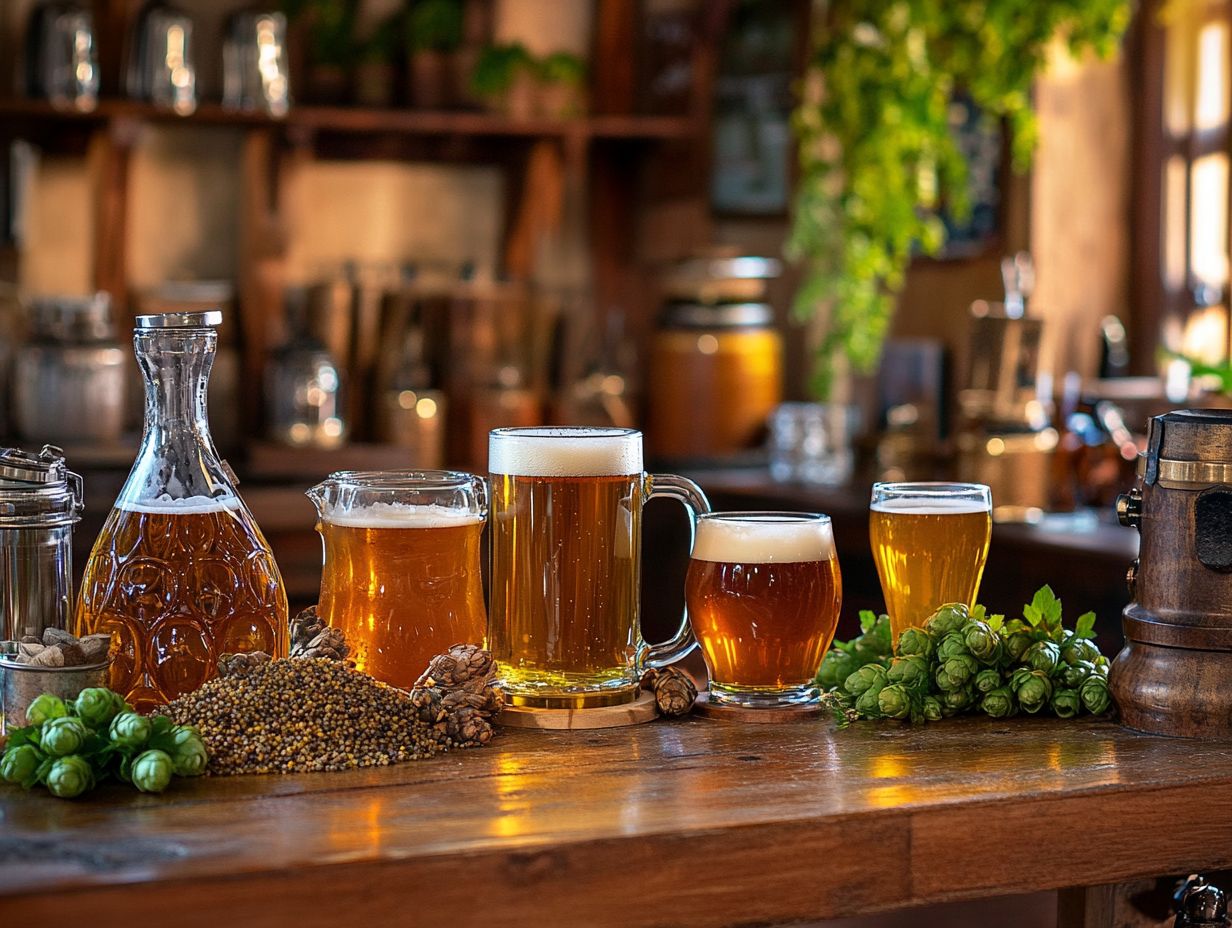
The Belgian Lambic is a truly unique style of beer that invites you into the world of spontaneous fermentation. Wild yeasts and local bacteria from your surroundings come together to craft complex and tart flavor profiles.
This process underscores the significance of open fermentation and aging in oak barrels, both of which contribute richly to the beer’s character and depth. Lambics, like Cranberry Lambic, create delightful variations.
While brewing a Lambic demands your patience and precision, the end result is a distinctive beer that embodies the very essence of Belgian brewing tradition.
To begin your brewing journey, carefully select the right grains. A mix of malted barley and unmalted wheat enhances your beer’s unique texture.
After mashing, boiling, and cooling the wort, the next pivotal step is to place it in an open vessel. This is where the magic happens, as local yeast and bacteria are free to inoculate your wort through spontaneous fermentation.
Fermentation is a slow dance, often taking several weeks to months. You’ll need to maintain an optimal environment to ensure everything goes smoothly.
Once fermentation wraps up, aging your beer in oak barrels for at least a year is essential. This is where the complex flavors truly blossom.
For those adventurous homebrewers among you, don’t hesitate to experiment with blending different batches to achieve your desired taste. Keeping detailed notes on yeast activity and environmental conditions is a must, as these factors can vary significantly and impact your final product.
This level of care is also emphasized in brewing techniques shared by experts like Breand n Kearney.
Tips for Brewing the Perfect Belgian Beer
Brewing the perfect Belgian beer is an exciting challenge! It requires a profound understanding of various brewing techniques and a keen appreciation for the nuances of fermentation and unique ingredient selection.
This process is steeped in brewing heritage, as seen in Brussels and other regions famous for their artisanal beers.
Each phase of the brewing process presents its own set of challenges, from selecting the ideal yeast strain to meticulously maintaining optimal fermentation temperatures. All of these play a crucial role in shaping the final flavor and quality of the brew.
Understanding these brewing challenges is key to mastering the craft. By mastering these essential elements, you can craft exceptional Belgian-style beers that genuinely capture the artistry and tradition of Belgian brewing.
These skills align with the teachings of the Institute of Brewing and Distilling, a vital resource for many brewers. Start brewing your own Lambic today and experience a taste of Belgium at home!
Choosing the Right Yeast
Selecting the right beer yeast is crucial when brewing Belgian beers, as various yeast strains can dramatically shape the flavor, aroma, and mouthfeel of your final creation. This is particularly important in styles like Dubbel style, Tripel style, and Quadruple style.
Take Belgian Ale yeast, for example. It s renowned for crafting complex flavors that dance with hints of banana and clove perfect for styles like Belgian Witbier and Dubbel.
On the other hand, strains like Brettanomyces, a wild yeast strain known for its unique flavors, lend an earthy funk, ideal for those unique sour ales you ve been wanting to try.
If you re aiming to replicate specific styles, it’s essential to consider these profiles carefully. An Abbey yeast might just be your go-to for a rich, malty Quadrupel, while a Saison yeast could add delightful dry, peppery notes to your farmhouse ale.
Don’t shy away from experimenting with different yeasts; it can lead to exciting and personalized brewing adventures that truly reflect your unique taste. This philosophy is embraced by many contemporary craft beer brewers and celebrated in the vibrant craft beer culture.
Controlling Fermentation Temperature
Controlling fermentation temperature is vital for you if you’re aiming to produce high-quality Belgian beers. Temperature fluctuations can dramatically impact the yeast’s performance and the beer’s overall character. Each style demands specific temperature ranges to achieve optimal fermentation and flavor development, influencing the balance between fruity and spicy notes.
Take lighter Belgian styles like Witbier, for example. They thrive at lower fermentation temperatures, typically between 62-68 F (16-20 C), which enhances their refreshing qualities.
On the other hand, stronger ales such as Belgian Dubbel and Tripel flourish in warmer fermentation conditions, usually around 68-75 F (20-24 C), allowing for the emergence of complex, rich flavors. These temperature ranges are key in producing styles like Flanders Red and Flanders Brown.
Maintaining these precise temperature ranges can pose challenges, given the potential for fluctuations in ambient conditions, equipment limitations, or the scale of your production. Consider investing in temperature-controlled fermenters to elevate your brewing game!
Diligently monitoring the fermentation process is crucial for achieving your desired flavor profile and consistency across batches. This attention to detail is essential for brewing standout beers that impress your friends!
This meticulousness is important in a variety of brewing processes, including those used in Trappist beers, which are brewed by Trappist monks and known for their rich flavors, and Abbey beers.
Adding Unique Ingredients
Incorporating unique ingredients into your brewing process can truly elevate your Belgian beer, setting it apart in the vibrant landscape of craft beer. This is your chance to experiment with flavors and aromas that will make your brew memorable.
Think about adding spices, fruits, and specialty malts; these elements can contribute to the complexity and richness that define Belgian-style beers. It s all about careful consideration and balance adding these ingredients in a way that enhances rather than overwhelms your beer’s character.
When you choose to include elements like orange peel, coriander, or even exotic fruits such as lychee and passion fruit, you’re inviting intriguing notes that harmonize beautifully with the traditional yeast profiles.
The impact of these unique ingredients can be profound, crafting a captivating bouquet that entices the senses. This is a practice often celebrated in beer recipes shared among homebrewers.
Approach these additions thoughtfully. Start with small quantities so you can make gradual adjustments through tasting as you brew.
A good rule of thumb is to let the base flavors shine while ensuring that the novel ingredients complement, rather than compete with, the established Belgian character. This creative yet conscientious approach encourages you to innovate while paying homage to the rich heritage of Belgian brewing.
Pairing Belgian Beer with Food
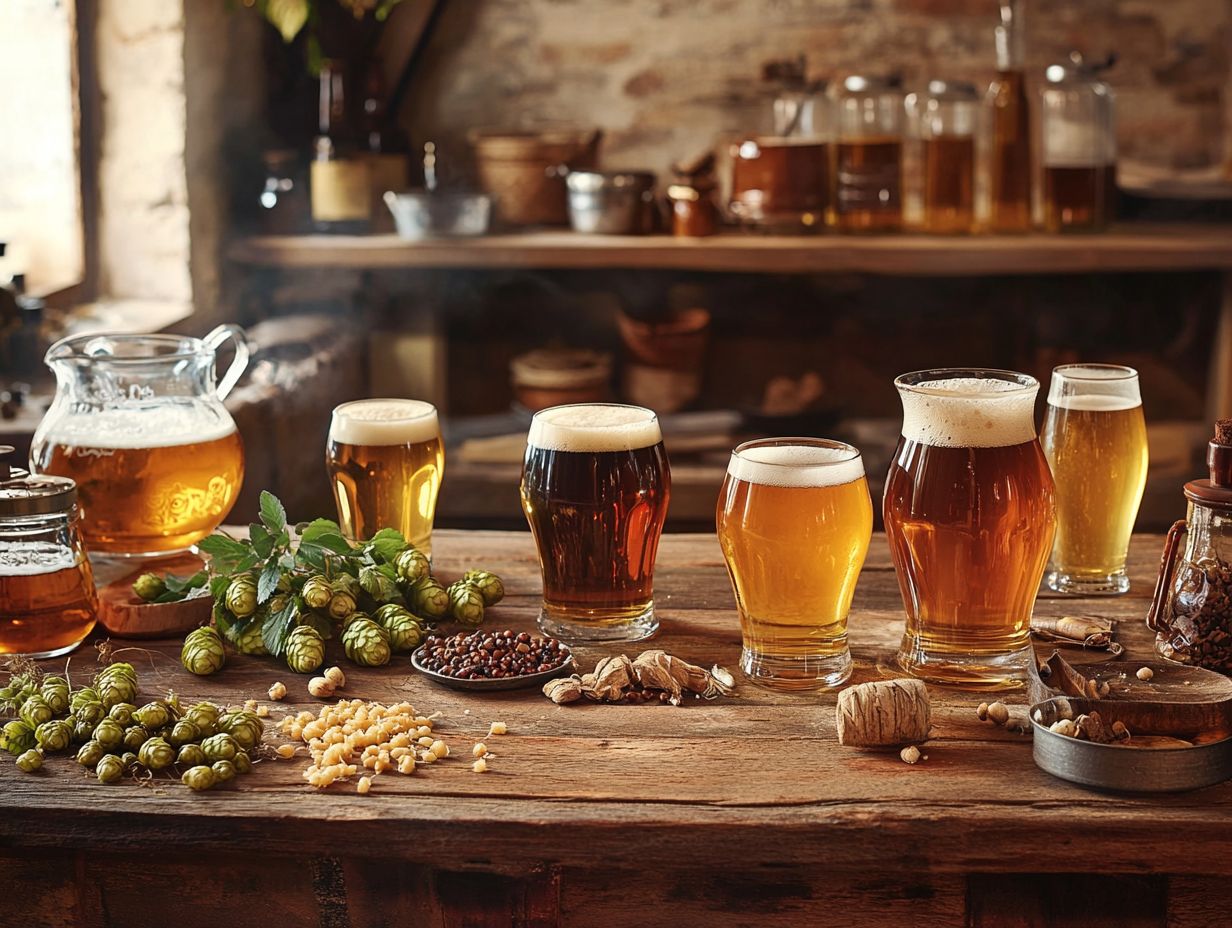
Pairing Belgian beer with food opens up exciting culinary possibilities. The unique flavors and aromas of Belgian brews can enhance a variety of dishes. This is an integral part of beer culture and a highlight of many beer festivals like the Bruges Beer Festival.
The rich complexity of Belgian ales spanning from fruity and spicy to malty and sweet invites you to explore creative pairing options that elevate both the beer and the cuisine. Understanding beer tasting and food pairings can enhance your dining experience. This knowledge is perfect for both beer lovers and food enthusiasts looking for the ideal match.
Belgian Beer and Cheese Pairings
Pairing Belgian beer with cheese is a timeless culinary art that allows you to explore and celebrate the unique flavors of each, creating a delightful balance that tantalizes your taste buds. Belgian beers, particularly those from Trappist and Abbey breweries (breweries known for their traditional and rich beer-making processes), are renowned for their complexity, making them the perfect companions for a wide range of cheeses from creamy, mild options to robust, aged varieties.
To achieve the ultimate flavor balance, it s crucial to consider the style of beer alongside the characteristics of the cheese. For example, a fruity Lambic, with its delightful tartness, pairs exquisitely with creamy Brie, enhancing the cheese’s luxurious richness. In the same vein, the spicy undertones of a Saison can beautifully highlight the nuttiness in Gouda, creating an overall taste experience that s simply divine.
If you find yourself drawn to bolder flavors, the dark maltiness of a Belgian Dubbel is a match made in heaven for blue cheese. Meanwhile, the citrusy zest of a Tripel can cut through the richness of aged cheddar, allowing each bite and sip to be a thrilling exploration of taste. Embrace this journey and enjoy the remarkable pairings that await you. Such pairings are often highlighted in beer tasting events across Belgium.
Explore the world of Belgian beer and cheese today for an unforgettable culinary adventure!
Belgian Beer and Chocolate Pairings
The combination of Belgian beer and chocolate offers you a luxurious tasting experience. The rich flavors of both can beautifully complement and enhance one another.
Belgian beers, with their diverse profiles, pair exceptionally well with various types of chocolate, ranging from dark and bittersweet to creamy milk chocolate. As you explore these pairings, you’ll uncover delightful discoveries that elevate both the beer and chocolate to new heights.
Imagine savoring a classic dark Belgian stout that intensifies the deep cocoa notes of high-quality dark chocolate. This creates a delicious combination that brings out the best in both.
Alternatively, a fruity Belgian lambic can brighten the flavors of a milk chocolate bar. This refreshing contrast excites your palate. You might also enjoy a Westmalle Tripel or a Rochefort 8 to experience the unique flavors that Belgian ales offer.
As you venture into these delightful combinations, keep a few tips in mind to enhance the experience:
- Consider the intensity of both the beer and the chocolate. Note the fruity notes and spicy notes that can add complexity.
- Aim for complementary flavors that work well together.
- Don t shy away from experimenting with unexpected pairings, like those you might find at a beer festival.
With a touch of creativity and a spirit of exploration, you can craft memorable tasting moments that celebrate the artistry of both Belgian brews and exquisite chocolate confections. Engaging in beer pairing and beer tasting events can further enhance your understanding and appreciation of these delightful combinations.
Frequently Asked Questions
What makes Belgian beer recipes special?
Belgian beer recipes are specific combinations of ingredients and techniques used to create traditional and unique beers from Belgium. They reflect the region’s rich brewing heritage and beer culture.
Why is exploring Belgian beer recipes important?
Exploring Belgian beer recipes allows for a deeper understanding and appreciation of Belgian beer culture and history. It also facilitates the creation of unique and delicious beers.
Engaging with the brewing process and learning about brewing techniques and fermentation methods used in Trappist breweries can be particularly enlightening.
What are some common ingredients in Belgian beer recipes?
Some common ingredients in Belgian beer recipes include malted barley, wheat, hops, and beer yeast. Unique ingredients such as fruits, spices, and herbs may also be used.
The inclusion of Belgian ingredients often contributes to distinctive flavors.
Are there different styles of Belgian beer recipes?
Yes, there are many different styles of Belgian beer recipes, each with its unique characteristics and flavor profiles. Popular styles include Dubbel style, Tripel style, and Belgian Saison.
You might also explore styles like Flanders Red and Flanders Brown.
Can I make Belgian beer recipes at home?
Yes, with the right ingredients and equipment, you can make Belgian beer recipes at home. However, it may take some practice and experimentation to perfect these recipes.
Trying out a Blue Moon Clone or a Cranberry Lambic could be a good start.
Where can I find Belgian beer recipes?
Belgian beer recipes can be found online, in books and magazines, or by visiting breweries and talking to experienced brewers. You can also create your own unique recipes by experimenting with different ingredients and techniques.
Find inspiration by exploring the work of brewers like Breand n Kearney or visiting festivals such as the Bruges Beer Festival.
Start your tasting adventure today!

